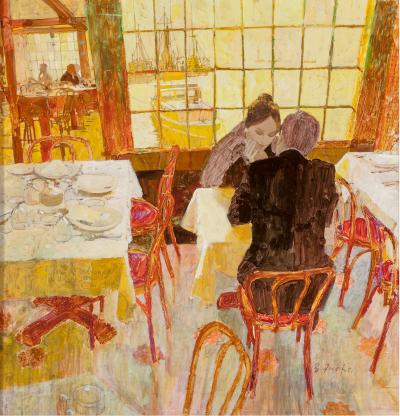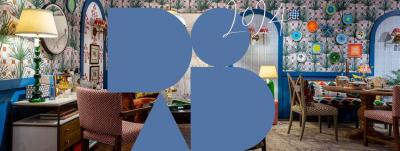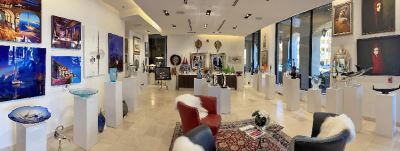The Whimsical Primitives of Ralph Cahoon
This archive article was originally published in the Summer 2003 issue of Antiques & Fine Art magazine.
Prominent collectors (Jacqueline Kennedy Onassis, Paul Mellon, and the DuPonts, to name only a few) began to acquire the work of Ralph E. Cahoon, Jr. (1910-1982) in the 1950s. Josiah K. Lilly III, heir to a pharmaceutical fortune, prominent Cape Cod philanthropist, and the founder of Heritage Museums and Gardens in Sandwich, Massachusetts, was so taken with his paintings that he and his wife purchased more than three dozen examples. Filled with a timeless spirit of innocence and whimsy, Cahoon's paintings are fantasies based in the nation's pre-industrial past when life seemed simpler. They present an opportunity to escape the pace of modern life.
Cahoon exhibited his work in galleries throughout the country while he was alive and, in the twenty years since his death, more than ten museum exhibitions of his work have been mounted in addition to the one currently on view at Heritage Museums.2
In the 1960s, Cahoon sold individual works for between $200 and $500; in the two years before his death in 1982, his paintings were selling for between $1,800 and $2,500. On August 5, 2000, Cahoon's Nantucket Clam-Bake was auctioned by Rafael Osona for a record-setting $179,900, and collectors continue to aggressively pursue his works. The escalating prices achieved at auctions in the Northeast over the past few years necessitate a closer look at Cahoon's art and at the reasons behind his artistic and commercial success.3
Cahoon's dashing sailors and charming mermaids who inhabit a setting reminiscent of nineteenth-century coastal New England have made him one of America's most popular and recognizable primitive painters. A lifetime spent seaside inspired his whimsical and often fantastical paintings that incorporated sailors, ships, whales, shells, and nautical devices.
The artist's trademark mermaids appeared in his work early in his career. These creatures, historically viewed as sirens who lured sailors to their doom, flirt and cavort shamelessly. Seemingly unimpeded by their tails, they climb trees, ride bicycles, play cards, drink tea, wash clothes, drive cars, dance, scull, fly kites, and bake pies.
A crisp delineation of form, a bright spectrum of color, and a self-assured attitude toward his subject characterize Cahoon's work. One critic wrote of Cahoon and his artist-wife Martha's acclaimed 1960 exhibition at Vose Galleries of Boston: "The Cahoons' paintings represent a fresh breath of life in the contemporary art world. The gay, cheerful colors, crisp technique and humorously fanciful subject matter are [a] refreshingly welcome oasis."4
Cahoon's work includes three distinct types: satires of historical events; satires of everyday events set against the backdrop of specific geographical locations; and fantastical scenes. His Boston Tea Party (private collection) typifies his historical satires with its depiction of mermaids and sailors dumping tea into Boston Harbor while a British soldier takes tea with a mermaid. Nantucket Incident (Fig. 1), with its imaginary episode in front of Nantucket's famous "Three Bricks" mansions built in 1835 by whale-oil tycoon Joseph Starbuck for his three sons, exemplifies his everyday scenes.
Hot-air balloons figure prominently in his fantasy scenes. Bon Voyage from Boston Harbor (Fig. 2) incorporates recognizable landmarks from Boston's skyline. The sale of this image set the stage for the current heights of the Cahoon market.5 Another fantasy scene, Mermaids and Icebergs (Fig. 3), epitomizes his style and combined several of his favorite motifs: a clipper ship, whales, and mermaids.
Born in the Cape Cod fishing village of Chatham, Massachusetts, on September 2, 1910, the oldest child of Ralph Eugene Cahoon and Susan Mae Small, Ralph E. Cahoon Jr. spent his youth clamming, fishing, and sailing. His love for the sea was matched by his passion for sketching. Encouraged by his parents, he enrolled in the School of Practical Art in Boston for two years, and then returned to the Cape. In 1932, he married Martha Farham, the daughter of Swedish immigrants, Axel and Elma Farham. A painter in her own right who had trained under her father, Martha became proficient in the art of Scandinavian decorative painting called rosemaling, a freehand style incorporating scrolls and flowers. Her style was inspired by Pennsylvania Dutch and Swedish designs. Ralph Cahoon also learned this technique from Martha.
The Cahoons settled in the Cape Cod town of Osterville in 1932, where they lived for ten years selling antiques, furniture, and accessories decorated with leaves, nautical motifs, and figures in the rosemaling tradition. Their only child, Franz, was born in 1935. Ten years later the family moved to nearby Santuit, an historic section of Cotuit, and permanently established their home, studio, and shop in a Georgian colonial house built by Ebenezer Crocker around 1775.
At the urging of art dealer and patron Joan Whitney Payson, the Cahoons began easel painting in 1953. After experimenting with both canvas and plywood, Ralph and Martha soon discovered that smooth, firm Swedish masonite best exhibited their technique. The couple liked to paint side by side, as illustrated in a photograph taken during the 1950s (Fig. 4). Working in a softer style with a pastel color palette, Martha's paintings exhibit a gentler sort of humor. She included the mermaid among her motifs but preferred to paint seascapes or pastoral landscapes with animals as well as versions of a Garden of Eden theme (Fig. 5).
Payson exhibited their work at her Country Art Gallery in Westbury, Long Island, where it always sold out immediately. The artists continued to show at her gallery until 1977, in addition to exhibiting nationally at galleries from Nantucket, Massachusetts, to Carmel, California.
For collectors, Ralph Cahoon's appeal is in his ability to capture the unique spirit and landscape of Cape Cod and other areas of coastal New England, while his subjects are charged with an underlying wit that is often playfully risque; without being vulgar.6

- The Cahoon Museum of American Art, Cotuit, Mass.
The Cahoon Museum of American Art in Cotuit, Massachusetts is preparing the Ralph Cahoon catalogue raisonné and organizing and exhibition of Ralph and Martha Cahoon’s decorated furniture for the summer of 2004. Please contact the musuem if you have an example of the Cahoon’s decorative accessories or furniture, or works by their circle that included Axel Farham, Eric Farham, and Peter Hunt.
The Museum collection includes paintings by the Cahoons and an impressive selection of nineteenth- and early-twentieth-century American art.
Earlier twentieth-century primitive painters, such as Grandma Moses, created works that disregarded the academic canons of perspective and foreshortening and utilized flat, often outlined, forms similar to primitive works of the late eighteenth and nineteenth centuries. Cahoon followed this tradition and successfully tapped into the romantic notion of a time when the spirit of adventure and opportunity were linked with the sea. Cindy Nickerson, director and curator of the Cahoon Museum of American Art in Cotuit, believes that the significance and popularity of Cahoon's work comes from his introduction of a daring sense of humor in a traditional and familiar style. He paved the way for other artists working in the primitive style.
In February 1982, at the age of 71, Ralph Cahoon died after a long illness. In 1984, the Cahoon Museum of American Art was established in Cahoon's home of thirty-seven years, where Martha continued to live until her death in 1999.
-----
This bio is not current.
Madelia Hickman Ring wrote this article when working at Wayne Pratt, Inc. She is currently a specialist in American Furniture, Folk Art and Decorative Arts and is a member of Bonham's Furniture & Decorative Arts Department, based in their New York office. She works closely with the San Francisco and Los Angeles offices to source Americana, as well as English and Continental furniture and decorative arts, for sale in New York.
This article was originally published in the Summer 2003 issue of Antiques & Fine Art magazine. AFA is affiliated with Incollect.
2. In 1972, a major exhibition of his work was shown at Heritage Plantation (now Heritage Museums and Gardens), Sandwich, Massachusetts.
3. At a Robert C. Eldred's auction on August 6, 1999, several Cahoon paintings brought more than $50,000 apiece: Sailor's Wedding brought $137,500; Transportation (The Race), $90,750; Jolly Tars of Sconset, $82,500; and Boston Tea Party, $79,750.
4. Anonymous critical review of a Vose Gallery exhibit, Duxbury Clipper (November 10, 1960).
5. In 1994, Wayne Pratt American Antiques, Inc. sold Bon Voyage from Boston Harbor to a private collector for $96,000.
6. Ronald Bourgeault of Northeast Auctions, as quoted in Laura V. School, "Ralph and Martha Cahoon," A-Plus Supplement (Spring 1995): 1-4.



















1.jpg)
















